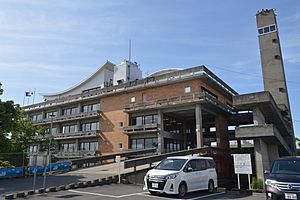Hashima, Gifu facts for kids
Quick facts for kids
Hashima
羽島市
|
|||
|---|---|---|---|

Hashima City Hall
|
|||
|
|||

Location of Hashima in Gifu Prefecture
|
|||
| Country | Japan | ||
| Region | Chūbu | ||
| Prefecture | Gifu | ||
| Area | |||
| • Total | 53.66 km2 (20.72 sq mi) | ||
| Population
(January 1, 2019)
|
|||
| • Total | 67,909 | ||
| • Density | 1,265.54/km2 (3,277.7/sq mi) | ||
| Time zone | UTC+9 (Japan Standard Time) | ||
| City symbols | |||
| - Tree | Juniperus chinensis L. 'Kaizuka' | ||
| - Flower | Mino Chrysanthemum | ||
| Phone number | 058-392-1111 | ||
| Address | 55 Takehana-chō, Hashima-shi, Gifu-ken 501-6292 | ||
Hashima (羽島市, Hashima-shi) is a city located in Gifu, Japan. As of January 1, 2019, about 67,909 people lived there in 26,327 homes. The city covers an area of about 53.66 square kilometers (20.72 sq mi).
Contents
Geography of Hashima
Hashima is in the southwest part of Gifu Prefecture. It sits on a flat area called the Nōbi Plain. The Kiso River flows to its east, and the Nagara River is to its west. Because much of the city is low, it can sometimes experience flooding.
Hashima's Climate
Hashima has a climate with hot and humid summers. Its winters are usually mild. The average temperature in Hashima is about 15.5 degrees Celsius (59.9°F). The city gets about 1849 millimeters (72.8 inches) of rain each year. September is usually the wettest month. The warmest month is August, with temperatures around 27.8 degrees Celsius (82.0°F). January is the coldest month, with temperatures around 4.1 degrees Celsius (39.4°F).
Neighboring Cities and Towns
Hashima shares its borders with several other places.
- In Gifu Prefecture:
- Gifu
- Ōgaki
- Kaizu
- Anpachi
- Wanouchi
- Kasamatsu
- In Aichi Prefecture:
- Ichinomiya
- Inazawa
Population Trends in Hashima
The number of people living in Hashima grew for a long time. Recently, the population has stayed about the same.
| Historical population | ||
|---|---|---|
| Year | Pop. | ±% |
| 1970 | 48,075 | — |
| 1980 | 56,975 | +18.5% |
| 1990 | 61,460 | +7.9% |
| 2000 | 64,713 | +5.3% |
| 2010 | 67,197 | +3.8% |
| 2020 | 65,649 | −2.3% |
History of Hashima
The area where Hashima is located was once part of an old Japanese province called Mino Province. During the Edo period (a time when Japan was ruled by the Tokugawa family), this land was split. Some parts were controlled by a powerful family called the Owari Domain. Other parts were directly controlled by the Tokugawa shogunate, which was the government at the time.
After the Meiji restoration (a big change in Japan's government), the area was organized into Hashima District, Gifu. On July 1, 1889, a modern system for towns and villages was created. This led to the formation of the town of Takenohana. Later, on April 1, 1954, Takenohana joined with nine nearby villages. Together, they officially formed the city of Hashima.
Hashima's Economy
Hashima is an important business center for its region. The local economy mainly relies on farming. It also has light industries, especially making woven cloth.
Education in Hashima
Hashima has several schools for young people. The city government runs eight public elementary schools and five public middle schools. There is also one public high school, which is managed by the Gifu Prefectural Board of Education. The prefecture also has a special education school in Hashima. For higher education, the Gifu College of Nursing is located in the city.
Getting Around Hashima
Hashima has good transportation links, especially by train and highway.
Train Travel
 Central Japan Railway Company (JR Tōkai) - Tōkaidō Shinkansen
Central Japan Railway Company (JR Tōkai) - Tōkaidō Shinkansen
- The Tōkaidō Shinkansen is a high-speed bullet train line. You can catch it at Gifu-Hashima Station.
 Meitetsu - Takehana Line
Meitetsu - Takehana Line
- The Meitetsu Takehana Line has several stops in Hashima: Minami-Juku, Suka, Fuwa-Ishiki, Takehana, Hashimashiyakushomae, and Egira.
 Meitetsu - Hashima Line
Meitetsu - Hashima Line
- The Meitetsu Hashima Line connects Egira and Shin-Hashima stations.
Highways
 Meishin Expressway
Meishin Expressway
- The Meishin Expressway is a major highway that passes through Hashima.
Images for kids
See also
 In Spanish: Hashima (Gifu) para niños
In Spanish: Hashima (Gifu) para niños





